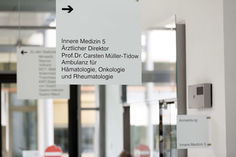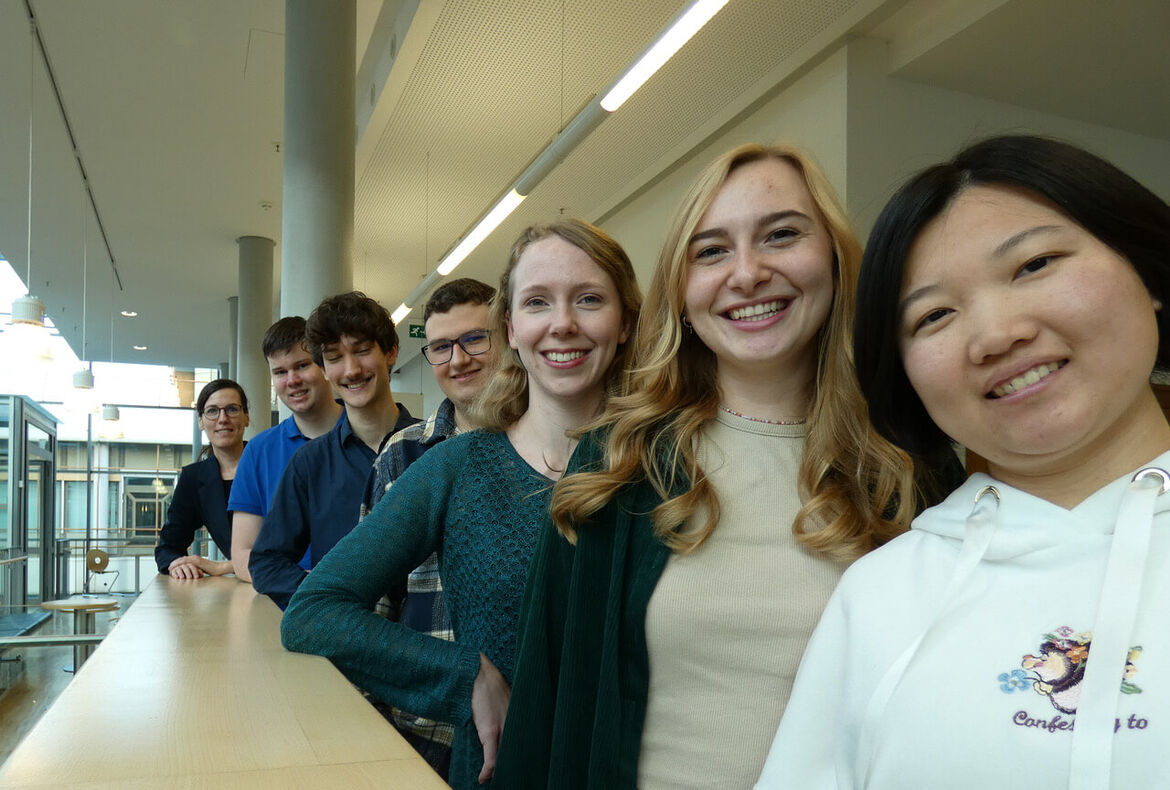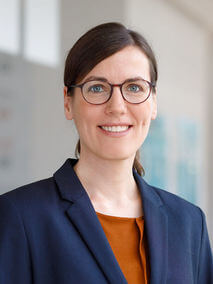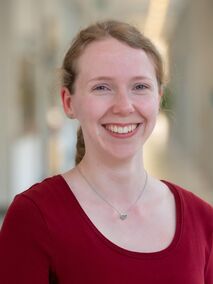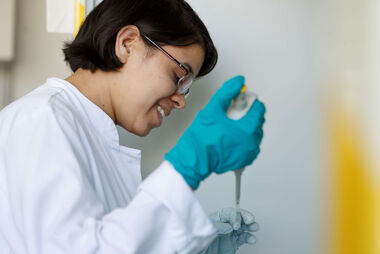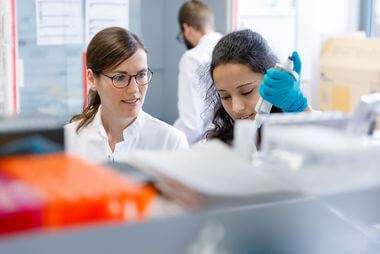Max-Eder-Research Group Pabst
"STEM CELL MECHANISMS AND THERAPY OPTIMIZATION IN ACUTE MYELOID LEUKEMIA"
Previous and current research
Despite increasing use of targeted therapies in the treatment of acute myeloid leukemia (AML) long term survival is rare in particular in elderly patients. Development of next generation sequencing (NGS) technologies providing detailed information on genetic lesions present in tumor genomes has improved risk stratification and paves the way for personalized therapy. Nonetheless, especially patients with high risk mutations often do not benefit from aggressive therapy regimens, which bear themselves the risk of treatment related mortality.
One major cause of relapse in AML is supposed to be the lack of therapies that permanently eradicate leukemia stem cells (LSCs). When human AML patient cells are transplanted into immunocompromised mice only a small fraction of cells is able to home to the bone marrow and recapitulate the human disease. These cells are called leukemia initiating, leukemia propagating, or leukemia stem cells. LSCs are considered to be the cause of relapse of the disease. They share certain features with normal hematopoietic stem cells such as higher resistance to chemotherapy and the capacity to self-renew. Due to these characteristics it is obvious that only efficient eradication of these LSCs will lead to long-term disease free survival. Our group aims to understand the similarities and differences between normal and malignant stem cells and to use this knowledge to develop more efficient therapies for AML patients.
Allogeneic hematopoietic stem cell tramsplantation (alloHCT) is a potentially curative therapeutic approach for many AML patients, but is itself associated with high treatment-associated morbidity and mortality (TRM). The efficacy of alloHCT mainly lies in the graft-versus-leukemia effect (GvL) mediated by donor-derived effector immune cells that recognize and eliminate residual leukemia stem cells. However, “non-self” recognition might also affect healthy cells resulting in acute or chronic graft-versus-host disease (GVHD). One focus of our research is therefore to enhance the GvL effect of alloHCT while reducing TRM thus improving relapse-free and overall survival of AML patients.
Furthermore, we explore the role of the bone marrow niche in promoting healthy hematopoiesis versus leukemia development in our Molecular Medicine partnership Unit “Stem cell-Niche-Networks” with EMBL Heidelberg: https://www.embl.org/about/info/mmpu/research-groups/stem-cell-niche-networks/.
Group leader

Curriculum Vitae Caroline Pabst
Max-Eder-Research Group Members

Forschungsgruppenleiterin
Postdoc
PhD Student MMPU (EMBL and Heidelberg University Hospital)
Biologielaborantin
Alumni
- Anna Mathioudaki
- Swati Garg
- Lixiazi He
- Jianglong Xia
Address
Medizinische Klinik, Abt. Innere Medizin V
Hämatologie, Onkologie, Rheumatologie
Im Neuenheimer Feld 410, F02, R607
69120 Heidelberg
Tel.: 06221-56-34121
Working in the lab
Research focus
Despite increasing use of targeted therapies in the treatment of acute myeloid leukemia (AML) long term survival is rare in particular in elderly patients. Development of next generation sequencing (NGS) technologies providing detailed information on genetic lesions present in tumor genomes has improved risk stratification and paves the way for personalized therapy. Nonetheless, especially patients with high risk mutations such as mutations in the tumor suppressor gene TP53 often do not benefit from aggressive therapy regimens, which bear themselves the risk of treatment related mortality.
Our aim ist o identify specific gene networks in AML with high molecular genetic risk using NGS technology, proteomics and in vivo models.
Leukemics Stem Cells (LSCs) can be distinguished from non-LSC blasts by their potential to engraft immunocompromised mice, in which they reinitiate the human disease. As they are supposed to be the cause of chemoresistance and relapse their eradication is a prerequisite for long term therapy success.

Fig. 1: Primary AML patients cells maintain their immature morphology in presence of optimized culture conditions (shown here day 4 in culture).
Our methods comprise in vitro manipulation of primary human AML cells and healthy hematopoietic stem cells, which we isolate from human cord blood. To avoid rapid differentiation upon in vitro culture we have optimized culture conditions for primary human cells including the use of small molecule (Fig. 1).
We knockdown and overexpress genes in primary cells using lentiviral transduction. Furthermore, the use of xenotransplantation models (NSG, NRGS mice) still represents the gold standard to assess stem cell activity.
With these approaches we aim to better understand the biology of normal and malignant stem cells and to develop more efficient therapies for AML patients.
Medical students searching for a project can send their application to caroline.pabst(at)med.uni-heidelberg.de.
Collaborators
- Guy Sauvageau (Leucégène Team), IRIC, Montreal, Kanada
- Fréderic Barabé, Quebec City, Kanada
- George Vassiliou, Cambridge, UK
- Jörg Hamann, GPCR consortium, Amsterdam, Niederlande
- Xianhua Piao, Boston, USA
- Claudia Waskow, Dresden
- Keith Humphries, Vancouver, Kanada
Selected publications
| The graft content of donor T cells expressing γδTCR+ and CD4+foxp3+ predicts the risk of acute graft versus host disease after transplantation of allogeneic peripheral blood stem cells from unrelated donors | Pabst, Caroline; Schirutschke, Holger; Ehninger, Gerhard; Bornhaeuser, Martin; Platzbecker, Uwe |
| Identification of small molecules that support human leukemia stem cell activity ex vivo | Pabst, Caroline; Krosl, Jana; Fares, Iman; Boucher, Genevieve; Ruel, Rejean; Marinier, Anne; Lemieux, Sebastien; Hebert, Josee; Sauvageau, Guy |
| Inherited and Somatic Defects in DDX41 in Myeloid Neoplasms | Polprasert, Chantana; Schulze, Isabell; Sekeres, Mikkael A.; Makishima, Hideki; Przychodzen, Bartlomiej; Hosono, Naoko; Singh, Jarnail; Padgett, Richard A.; Gu, Xiaorong; Phillips, James G.; Clemente, Michael; Parker, Yvonne; Lindner, Daniel; Dienes, Brittney; Jankowsky, Eckhard; Saunthararajah, Yogen; Du, Yang; Oakley, Kevin; Nhu Nguyen; Mukherjee, Sudipto; Pabst, Caroline; Godley, Lucy A.; Churpek, Jane E.; Pollyea, Daniel A.; Krug, Utz; Berdel, Wolfgang E.; Klein, Hans-Ulrich; Dugas, Martin; Shiraishi, Yuichi; Chiba, Kenichi; Tanaka, Hiroko; Miyano, Satoru; Yoshida, Kenichi; Ogawa, Seishi; Mueller-Tidow, Carsten; Maciejewski, Jaroslaw P. |
| GPR56 identifies primary human acute myeloid leukemia cells with high repopulating potential in vivo | Pabst, Caroline; Bergeron, Anne; Lavallee, Vincent-Philippe; Yeh, Jonathan; Gendron, Patrick; Norddahl, Gudmundur L.; Krosl, Jana; Boivin, Isabel; Deneault, Eric; Simard, Jessica; Imren, Suzan; Boucher, Genevieve; Eppert, Kolja; Herold, Tobias; Bohlander, Stefan K.; Humphries, Keith; Lemieux, Sebastien; Hebert, Josee; Sauvageau, Guy; Barabe, Frederic |
| Loss of the histone methyltransferase EZH2 induces resistance to multiple drugs in acute myeloid leukemia | Goellner, Stefanie; Oellerich, Thomas; Agrawal-Singh, Shuchi; Schenk, Tino; Klein, Hans-Ulrich; Rohde, Christian; Pabst, Caroline; Sauer, Tim; Lerdrup, Mads; Tavor, Sigal; Stoelzel, Friedrich; Herold, Sylvia; Ehninger, Gerhard; Koehler, Gabriele; Pan, Kuan-Ting; Urlaub, Henning; Serve, Hubert; Dugas, Martin; Spiekermann, Karsten; Vick, Binje; Jeremias, Irmela; Berdel, Wolfgang E.; Hansen, Klaus; Zelent, Arthur; Wickenhauser, Claudia; Mueller, Lutz P.; Thiede, Christian; Mueller-Tidow, Carsten |
| The Adhesion G Protein-Coupled Receptor GPR97 ADGRG3 Is Expressed in Human Granulocytes and Triggers Antimicrobial Effector Functions | Hsiao, Cheng-Chih; Chu, Tai-Ying; Wu, Chia-Jung; van den Biggelaar, Maartje; Pabst, Caroline; Hebert, Josee; Kuijpers, Taco W.; Scicluna, Brendon P.; Kuan-Yu, I; Chen, Tse-Ching; Liebscher, Ines; Hamann, Jorg; Lin, Hsi-Hsien |
| Hepatic leukemia factor is a novel leukemic stem cell regulator in DNMT3A, NPM1, and FLT3-ITD triple-mutated AML | Garg, Swati; Reyes-Palomares, Armando; He, Lixiazi; Bergeron, Anne; Lavallee, Vincent-Philippe; Lemieux, Sebastien; Gendron, Patrick; Rohde, Christian; Xia, Jianglong; Jagdhane, Prarabdha; Mueller-Tidow, Carsten; Lipka, Daniel B.; Imren, Suzan; Humphries, R. Keith; Waskow, Claudia; Vick, Binje; Jeremias, Irmela; Richard-Carpentier, Guillaume; Hebert, Josee; Sauvageau, Guy; Zaugg, Judith B.; Barabe, Frederic; Pabst, Caroline |
| Hotspot DNMT3A mutations in clonal hematopoiesis and acute myeloid leukemia sensitize cells to azacytidine via viral mimicry response | Scheller, Marina; Ludwig, Anne Kathrin; Goellner, Stefanie; Rohde, Christian; Kraemer, Stephen; Staeble, Sina; Janssen, Maike; Mueller, James-Arne; He, Lixiazi; Baumer, Nicole; Arnold, Christian; Gerss, Joachim; Schoenung, Maximilian; Thiede, Christian; Niederwieser, Christian; Niederwieser, Dietger; Serve, Hubert; Berdel, Wolfgang E.; Thiem, Ulrich; Hemmerling, Inga; Leuschner, Florian; Plass, Christoph; Schlesner, Matthias; Zaugg, Judith; Milsom, Michael D.; Trumpp, Andreas; Pabst, Caroline; Lipka, Daniel B.; Muller-Tidow, Carsten |
| CDK7/12/13 inhibition targets an oscillating leukemia stem cell network and synergizes with venetoclax in acute myeloid leukemia | He, Lixiazi; Arnold, Christian; Thoma, Judith; Rohde, Christian; Kholmatov, Maksim; Garg, Swati; Hsiao, Cheng-Chih; Viol, Linda; Zhang, Kaiqing; Sun, Rui; Schmidt, Christina; Janssen, Maike; MacRae, Tara; Huber, Karin; Thiede, Christian; Hebert, Josee; Sauvageau, Guy; Spratte, Julia; Fluhr, Herbert; Aust, Gabriela; Muller-Tidow, Carsten; Niehrs, Christof; Pereira, Gislene; Hamann, Joerg; Tanaka, Motomu; Zaugg, Judith B.; Pabst, Caroline |
| Humoral Responses and Chronic GVHD Exacerbation after COVID-19 Vaccination Post Allogeneic Stem Cell Transplantation | Pabst, Caroline; Benning, Louise; Liebers, Nora; Janssen, Maike; Caille, Leandra; Speer, Claudius; He, Lixiazi; Schubert, Maria-Luisa; Simons, Laura; Hegenbart, Ute; Schoenland, Stefan; Radujkovic, Aleksandar; Schmitt, Michael; Schnitzler, Paul; Mueller-Tidow, Carsten; Dietrich, Sascha; Dreger, Peter; Luft, Thomas |
| Combinatorial BCL2 Family Expression in Acute Myeloid Leukemia Stem Cells Predicts Clinical Response to Azacitidine/Venetoclax | Waclawiczek, Alexander; Leppae, Aino-Maija; Renders, Simon; Stumpf, Karolin; Reyneri, Cecilia; Betz, Barbara; Janssen, Maike; Shahswar, Rabia; Donato, Elisa; Karpova, Darja; Thiel, Vera; Unglaub, Julia M.; Grabowski, Susanna; Gryzik, Stefanie; Vierbaum, Lisa; Schlenk, Richard F.; Roellig, Christoph; Hundemer, Michael; Pabst, Caroline; Heuser, Michael; Raffel, Simon; Mueller-Tidow, Carsten; Sauer, Tim; Trumpp, Andreas |
| Clonally resolved single-cell multi-omics identifies routes of cellular differentiation in acute myeloid leukemia | Beneyto-Calabuig, Sergi; Merbach, Anne Kathrin; Kniffka, Jonas-Alexander; Antes, Magdalena; Szu-Tu, Chelsea; Rohde, Christian; Waclawiczek, Alexander; Stelmach, Patrick; Graessle, Sarah; Pervan, Philip; Janssen, Maike; Landry, Jonathan J. M.; Benes, Vladimir; Jauch, Anna; Brough, Michaela; Bauer, Marcus; Besenbeck, Birgit; Felden, Julia; Baeumer, Sebastian; Hundemer, Michael; Sauer, Tim; Pabst, Caroline; Wickenhauser, Claudia; Angenendt, Linus; Schliemann, Christoph; Trumpp, Andreas; Haas, Simon; Scherer, Michael; Raffel, Simon; Mueller-Tidow, Carsten; Velten, Lars |
| Statin-based endothelial prophylaxis and outcome after allogeneic stem cell transplantation | Pabst, Caroline; Schreck, Nicholas; Benner, Axel; Hegenbart, Ute; Schoenland, Stefan; Radujkovic, Aleksandar; Schmitt, Michael; Mueller-Tidow, Carsten; Orsatti, Laura; Dreger, Peter; Luft, Thomas |
| GRaNIE and GRaNPA: inference and evaluation of enhancer-mediated gene regulatory networks | Kamal, Aryan; Arnold, Christian; Claringbould, Annique; Moussa, Rim; Servaas, Nila H.; Kholmatov, Maksim; Daga, Neha; Nogina, Daria; Mueller-Dott, Sophia; Reyes-Palomares, Armando; Palla, Giovanni; Sigalova, Olga; Bunina, Daria; Pabst, Caroline; Zaugg, Judith B. |
| The remission status of AML patients post alloSCT is associated with a distinct single-cell bone marrow T cell signature. | Mathioudaki, Anna; Wang, Xizhe; Sedloev, David Nikolov; Huth, Richard; Kamal, Aryan; Hundemer, Michael; Liu, Yi; Vasileiou, Spyridoula; Lulla, Premal D; Muller-Tidow, Carsten; Dreger, Peter; Luft, Thomas; Sauer, Tim; Schmitt, Michael; Zaugg, Judith B; Pabst, Caroline |
